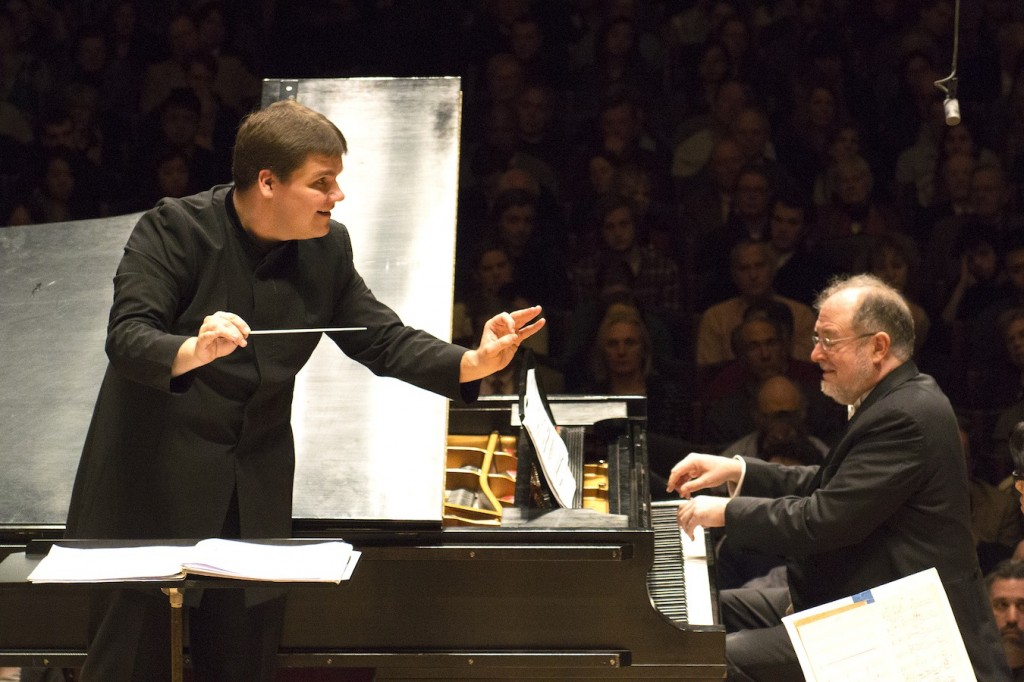Poga confidently leads BSO in Symphony Hall debut

Garrick Ohlsson performed Lutoslawski’s Piano Concerto Thursday night with Andris Poga and the Boston Symphony Orchestra. Photo: Stu Rosner
The Boston Symphony Orchestra’s Latvian invasion kicked up another notch Thursday night with the subscription series debut of the Riga-born BSO assistant conductor Andris Poga, leading an agreeably off-center program of less-familiar works by familiar composers.
Wagner was represented not by Rhine journeys or love-deaths but by the Overture to his earliest operatic success, Rienzi. The late Witold Lutosławski, whose symphonies and Concerto for Orchestra have left their mark on the repertoire, was heard Thursday in a more elusive, later work, the Piano Concerto (with Garrick Ohlsson as soloist). The Shostakovich symphony performed on Thursday was not one of the spectaculars such as No. 1, 5, 7, or 10, but the enigmatic No. 15, the last in the series.
Most Wagner fans would agree that, when imitating the grand-opera style of Meyerbeer in Rienzi, the future master of music drama made more noise than sense. And yet the opera was quite a hit in its day, and according to the BSO performance history, its overture was a regular visitor to Symphony Hall during the first third of the twentieth century.
That popularity could hardly have been based on the kind of caricature performance heard Thursday night. It would have been enough to let the piece go a little bombastic at times, as it clearly wanted to do, rather than insist on the point throughout the allegro.
While admiring the orchestra’s smart response to Poga’s vigorous direction, one was also aware of the opportunities for lyricism and fun that were being missed amid the braying brass and clacking percussion. If this was “authentic performance practice” for grand opera c. 1840, maybe the performance could have used a little less of it.
With Lutosławski, we are fortunate to have the recent memory of the composer’s own performances at the piano and on the podium to guide us toward the “authentic.” Still, what are we to make of the brainy modernist whose composition gods included such red-blooded characters as Bartók, Chopin, and even Rachmaninoff?
On Thursday night, the performers elected to serve the Piano Concerto straight up and very dry, shaken not stirred. Like Agent 007, pianist Ohlsson occasionally showed his romantic side, but generally carried out his mission with dispatch and sang-froid. One often admired his restraint and control—in rapid, delicate dialogue with the orchestra, for example, or in the big, round fortissimos, full-toned but never banged.
Pianist and conductor deftly outlined the Russian-style concerto format: intricately worked first movement, combined scherzo-andante, fast and witty finale. Ohlsson projected the mostly-solo Largo movement with sustained expression. But still, in those Rachmaninoffian moments when a torrent of notes burst forth or piano octaves rang out over a busy orchestra, one wished the performers had loosened the reins a little.
The orchestra seemed to come back after the intermission a different instrument. (Literally true, in a sense—many first-chair players were in their seats for the first time that evening.) As flutist Elizabeth Rowe opened the Shostakovich symphony with a dancing solo over a vital string pizzicato, the ensemble seemed already to have entered a higher plane of music-making than heard earlier. That impression was confirmed repeatedly throughout the antic first movement, as Poga evoked ever-shifting moods and colors from his nimble players.
The composer once told an interviewer that this piece came to him all at once, and the main effort was writing it all down. And in fact, lovers of the tortured, furious Shostakovich of other works may be puzzled by the “what me worry?” character of this one. On Thursday night, a retrospective haze settled over the Shostakovich oeuvre, as the old, ailing composer alluded to previous music by himself and others (Wagner, Tchaikovsky, even Rossini’s William Tell Overture), and the sarcasm and anguish of earlier days were transformed into benign humor and the occasional bracing sforzando.
There was ease rather than struggle in the way the second movement’s oppressive, liturgical brass phrases were banished by tender solos, especially the eloquent cello of Jules Eskin. Things went a little too lax in the grotesque scherzo, which sounded somewhat dull and matter-of-fact compared to the fizzy, on-your-toes rendering of the first movement.
But the players rediscovered their sense of play and nuance in the intriguing finale, blending a dark Wagner “fate” motif with a subtle set of variations. Expert dovetailing by Poga and the orchestra linked the variations together, sustaining suspense through long quiet passages until the fortissimo climax finally arrived.
Then, in the coda, the ever-resourceful BSO percussion section vividly evoked a ticking, whirring clock shop—closing this work, and this composer’s entire symphonic epic, with a humorous if slightly unsettling memento Timex.
The program will be repeated 8 p.m. Saturday. bso.org; 617-266-1200.
Posted in Performances



